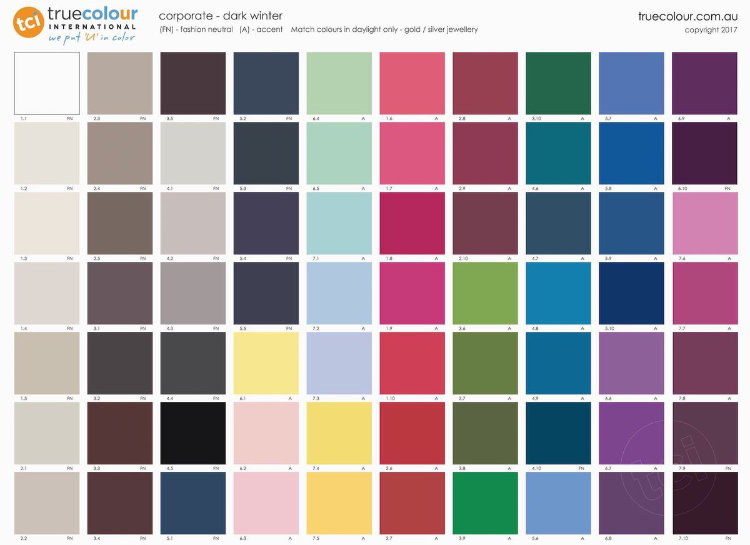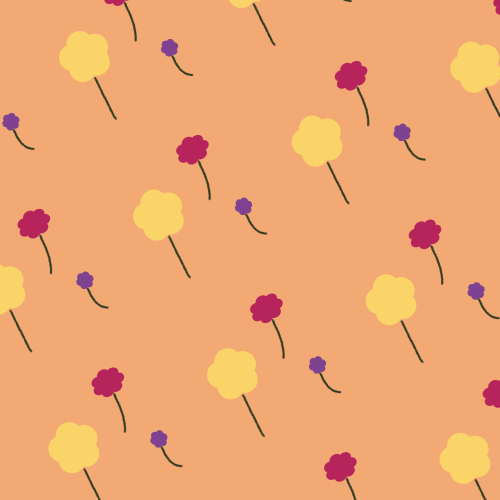Dark Winter: The Ultimate Guide
Dark Winter colours are captivating.
All Winters represent night in some way, since they all contain black, but none more so than Dark Winter.
These are the colours of the gathering storm, of vast mountain ranges and forbidden forests.
As in the other two Winters we see these colours in icy and snowy landscapes, but there’s more rock and forest in this picture.
They also remind me of an oil slick — rainbow colours, but with a dark base.
Related: Images in 12 Tones
The palette
Dark Winter colours are rich, deep, luxurious, dramatic and powerful.
In our 12 tone chart, Dark Winter falls on the path from True Winter to True Autumn. It combines True Winter’s sharp, cool and contrasting palette with a touch of Autumn’s rich earthiness.
This is especially visible on the warmer side, which appears quite autumnal, but the whole palette has a slight smokiness when compared to True Winter.
So where do Dark Winter colours sit on the 3 dimensions of colour?
While some are very light (white and icy colours), there are many more dark ones, and overall the palette is low in value.
They are fairly high in chroma (saturation).
The colours are neutral-cool, so they contain both blue and yellow undertones, but more blue than yellow.
Compared to Dark Autumn these colours are brighter and cooler. Overall they're similarly dark, but Dark Winter has much lighter lights.
Compared to True Winter these colours are softer, warmer and darker.
Compared to Bright Winter these colours are the same temperature — neutral cool — but are softer and darker.
Dark Winter colour dimensions
For more about Dark Winter colours, see The Value of Colour and In Search of 12-Tone’s “Icy” Lights from Amelia Butler at True Colour International.
Clothing
If you’ve just discovered that you are a Dark Winter, and you’re learning how to create a Dark Winter wardrobe, congratulations! These are spectacular colours.
The good news is that, as a Winter, black is in your palette.
Since most people have wardrobes already containing a lot of black, and because black is so easy to find in shops, this puts you at an advantage.
There are different blacks, just like there are different whites — your best black is on the cover of your TCI Dark Winter fan.
But if you can’t find exactly the right one, simply mixing most blacks with one or two of your other colours will make sure the overall effect is Dark Winter.
You can use literally any of your colours to do this, but here are some ideas:
Of course, you don’t need to use black at all. I just started there because so many people have it.
Any colours will mix with any others in the palette. That’s the beauty of harmonious colours.
Like all Winters, Dark Winters suit high contrast combinations. Dark/light, dark/bright and dark/bright/light combinations all work well. You’ll also do well in an all-dark look, better than the other Winters, but an all-light look will not be as flattering.
If you have a TCI Dark Winter fan, you’ll see some ideas about how to combine colours on the last arm of fan. (You can also see some on the classic palette image further up this page.)
You can combine your colours however you like — that’s the magic of tonal palettes — but they’re some ideas to get you started.
Speaking of which, let’s see some examples of outfits for women and men in Dark Winter colours:
Related: Women’s Fashion in 12 Tones
Related: Men’s Fashion in 12 Tones
For more inspiration, True Colour has a 12 Tone Dark Winter Pinterest Board showing wardrobe ideas for men and women, as well as a blog post of palette-matched Cashmere Pashminas for Winters.
Corporate Clothing
When I’m discussing corporate clothing here, I’m talking about more conservative workplaces — if yours is more casual, this may not be relevant for you.
That said, corporate clothing, in terms of colours, usually consists of some or all of these:
Neutral colours
Dark colours
High value contrast (light/dark)
The classic example is a grey or black suit with a white or light-coloured shirt or blouse, and possibly an accent colour in a tie or jewellery.
This is effortless for Winters.
Colour combinations that can work for you include the ones I’ve shown above; those shown on the last arm of the TCI Dark Winter corporate fan, and these:
For more on corporate clothing, see Dark/True Winter Corporate Women from True Colour.
Patterns
Matching solid colours to your fan is one thing; matching patterns can be a trickier task.
If harmonising with the fan is too hard, try checking it against your face. If the colours are right, you’ll see the same effects you saw during your draping, like vitality, happiness, 3-dimensionality and authenticity.
What if most of the colours in a pattern are Dark Winter, but there’s one that clearly isn’t? Does it matter?
There’s no absolute rule here, unfortunately. It depends.
But you’re more likely to get away with it if the non-Dark Winter colour is:
closer to Dark Winter, like True Winter navy as opposed to True autumn orange
more neutral — an incorrect grey will be less problematic than an incorrect blue
a small element in the print
As an example of the latter, the first pattern below contains just Dark Winter colours. The second introduces small flowers in a Light Spring apricot; the third covers the background with that apricot colour.
The first is perfect. The second isn’t, but the overall effect is still more Dark Winter than anything else, and you could get away with it. The last would be a disaster on you.
Metals, jewellery, watches and glasses
The best metals for Dark Winter are silver and pewter. Gold also works, and is especially useful to warm up an outfit which is slipping into True Winter territory. The best gold has some depth to it, but is closer to yellow than orange.
Metals can be shiny, but I especially love antiqued metals on both Dark tones (Dark Winter and Dark Autumn).
Dark Winter stones have depth, drama and luxury. Think rubies, garnets, emeralds, amethysts. Diamonds work here, as they do for all Winters, but are quintessentially Dark Winter in an antique setting.
Glasses frames can be any of the metals discussed above, black, or any of the colours in the palette.
Hair colour
I’ve collected some hair colour options for Dark Winters in the Pinterest board below. They are dark, as the name would suggest. Dark Winters usually only go light when they go grey, which tends to look incredibly striking, and infinitely better than blonde.
Makeup
Complexion makeup (foundation, concealer, etc.) needs to be matched to your skin. If you have trouble finding or matching foundation, I have a blog post that might help.
The “colour makeup” comes from your Dark Winter palette.
Dark Winter neutrals
For a neutral eye makeup, you can use eyeshadows in your whites and taupes, greys and browns, even black for more drama.
Taupe, brown or black for brows, whichever is most similar to your natural brows.
Brown or black eyeliner, and as always for Winters, black mascara.
Dark Winter purples, blues and greens
Or, if you like more colourful makeup, use any of the accent colours in your palette. Burgundy or navy eyeshadow, emerald or amethyst liner.
Dark Winter reds and pinks
Blush and lip colours come from the red, pink and coral area of your palette. All will work on you, but most women will find their perfect shade is somewhere within this range, so trial and error may be necessary here.
As in all three Winters, lip colours here can seem intimidating, even too dark for a natural look. Keep in mind, though, that what looks dramatic or even gothic on others will look more at home on your face.
If the lip colours feel too strong, try:
a lighter colour in your palette — there are some medium corals, pinks, plums and berries that can be my-lips-but-better on Dark Winter women;
a sheer formulation like a gloss, balm or sheer lipstick;
applying your lipstick over a clear lip balm, which will sheer it out;
applying your existing lipstick lightly, then blotting it away to create a stained lip; or
skipping lip colour altogether.
For more on your lip colours, see Embracing Winter Lips from Truth Is Beauty.
The same strategies apply with blush, if the colour feels too intense or strong. Go sheerer, by applying product much more sparingly, or using a cream blush (or lipstick used as blush).
Related: Makeup Looks in 12 Tones
The classic Winter makeup look is the pin-up look, with light eyeshadow, winged black liner and a red lip. For a Dark Winter the lip is deeper, blood red or wine.
But that’s far from your only choice. Dark Winter gets more browns than True or Bright Winter ... they’re closer to mahogany than chocolate, but they’re there, and they make for more varied neutral eye looks.
The smoky eye is perfect for Dark Winter, both the classic black and grey, and the richer, browner version.
For less drama, a wash of taupe eyeshadow and a black mascara is a simple day look.
I don’t love bronzer on any Winter (or Summer for that matter). It’s more sensible here than on the other two Winters, because you have the small element of earthiness in your colours that Autumn brings. I personally find it too small to really work.
You’re more jewel-toned than earth-toned, and can easily be muddied.
Weddings
If you’re getting married, congratulations!
Wearing your suit or dress and accessories (like a boutonnière or bouquet) in your colours will bring out your best on your wedding day.
Dark Winter suits are black, charcoal, or navy blue, even wine, with a white shirt to play up contrast, or a dark shirt for drama. Add a red or black rose as a boutonnière, or even a peacock feather.
While white is in your palette, head-to-toe light will be too lacking in depth and contrast for you to look your best. Add depth in a sash on the dress, in your bouquet, jewellery and makeup.
Or go pre-Victorian with a non-white dress. You have some amazing colours to choose from if you decide to branch out.
You can even theme your whole wedding in Dark Winter colours. They make for a lush, dramatic, captivating wedding.
Related: Wedding Inspiration in 12 Tones
Living spaces
Dark Winter colours can make for luxurious, dramatic décor.
While not used extensively in home design, they’re more common in modern and high end designs, as you can see below.
Related: Living Spaces in 12 Tones
Pin this:



















